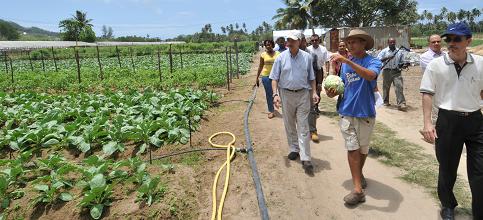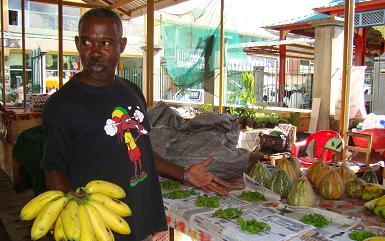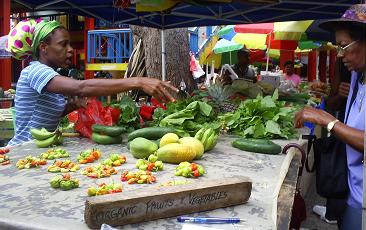A review of the agricultural sector in 2008-Towards a higher national food security |31 December 2008

The world food situation was further aggravated by the world economic disposition primarily dictated by the price of oil on the world market. This was complicated even more by the world economic meltdown at the turn of the year.
Furthermore, the impacts of the ever greater frequencies of extreme weather events such as droughts and floods were compounded by outbreaks of livestock and plants pests and diseases affecting the basic foods production throughout the globe. These production and market constraints led to soaring prices of basic foods worldwide inducing the outbreak of violence and food riots in many countries where the price of these items more than doubled. Even Australians in an otherwise rich agricultural country queued up for meals charity. While the world community grappled with the emerging difficulties of meeting the second most important physiological need, Small Island Developing States like the Seychelles contemplated the many options for survival of their populace.
An assessment of the national agricultural output late in 2007 had indicated that more than half of the food consumed was produced locally. Indeed, 100% of the table eggs, 70% of the broiler chicken, and some 60% of the pork, vegetables and fruits consumed were being produced locally. The balance of the foods consumed was being made up through imports and contributed to the rising costs of imports in the face of scarce foreign exchange resources.
Seychelles had launched its Agricultural Development Strategy (ADS) 2007-2011 in October 2007 following intense consultations with stakeholders. The said strategy laid the foundation for a revised agricultural development in the Seychelles and set the pace for the agricultural development in the next five years. It was endorsed as the second generation sector document after the Agricultural Development Policy of 1992/1993. It identified the stakeholders and attributed roles to them. The State took on the responsibility to provide a conducive environment for agricultural production while the responsibility of food production was vested into the hands of the food producing entrepreneurs or farmers. The ADS 2007-2011 also set targets for agricultural production over the next five years. It proposed meeting the entirety of demands (100%) for broiler chicken, table eggs and pork, and a minimum of 80% of fruits and vegetables consumed through local production. It established that local agricultural production would only exploit agricultural production domains for which there were comparative advantages. It would favour the importation of other produces for which there were no local comparative advantages in their production. It reasoned that the national agricultural efforts would have to be complemented by both bilateral and multilateral cooperation efforts and hence the need to re-enforce actions of international cooperation. These actions were to be firstly manifested through established regional groups such as the IOC, COMESA and recently the SADC.
In this regard, Government took the opportunity to also launch the Comprehensive Africa Agriculture Development Programme (CAADP) alongside the ADS 2007-20011, bringing Seychelles into the fold of African Union (AU) countries implementing the programme. The CAADP, a programme of agricultural development along four pillars, provided further synergy to the ADS 2007-2011 as it also addressed similar issues.
Food Security Strategy 2008 – 2011
In the early part of 2008 there were increasing media reports of soaring food prices not only attributed to high world demand but also due to failing crops as a consequence of bad weather either as a result of prolonged droughts or floods from continuous heavy downpours. By the end of March 2008 it had become clear that unless the Seychelles Government came up with a rapid response the country might face unprecedented food security issues. Government immediately responded through a series of national actions by engaging all national stakeholders to reflect on how to counter this threat. This was achieved through a series of intense consultations throughout April and May 2008 and it culminated in the launch of the Food Security Strategy (FSS) 2008-2011. The FSS 2008-2011, a Comprehensive Framework for Action, translates the aspirations of the ADS 2007-2011 into an action plan for immediate execution. Thus the ADS 2007-2011 provided the platform for the launch of the FSS 2008-2011 which focus on five leverage points onto which actions were required. The five leverage points are as follows: (i) agricultural land and its use optimization, (ii) agricultural inputs and supplies, (iii) agricultural infrastructure, (iv) agricultural policy and institutional support, and (vi) human resource development and training.
The field translation of the FSS 2008-2011 would lead to a higher national food security. It would require institutional support and the execution of a series of pertinent actions. In part, Government paved the way by setting up two committees of relevant stakeholders. The Technical Committee for Agricultural Development would address issues on the field and would augur for technical solutions to iron out these issues. The National Committee for Agricultural Development chaired by the Minister for Environment, Natural Resources and Transport deliberates on institutional and administrative hindrances with a view to address such issues. The primary focus nonetheless remains on ironing out issues around the five leverage points. Nonetheless, the five leverage points preoccupy themselves with land based food production activities. It is noted that sea based food production aspects were addressed in the Fisheries Development Strategies launched in 2006.
Agricultural land and its use optimization
Agricultural land and its use optimization was found to be primordial in any agricultural development toward national food security. Socio-economic development over the last 20 years was strongly biased towards social housing and tourism and in the process sacrificed much agricultural land. An assessment in the mid 2000s revealed that some 600 hectares were under some form of agricultural production of which only 200 hectares were being cultivated intensively. In juxtaposition to that the balance of 400 hectares was being inefficiently used by the farming occupants.
In a large number of cases the under-utilised land was State owned and found within the so called blockers schemes traditionally located at the Anse Boileau, Val D’Andorre and Amitie of Praslin. It is paramount that any move toward enhancing national food production should be complemented with a parallel effort of identifying additional land resources. There are two sources for such resources: one would be the new land resources while the other would be the existing land resources which are being under-utilised. Indeed, Government made decisions in April 2008 to both identify new agricultural land resources and adopted strong policy positions towards under-utilised agricultural State land. The allocation of the 15 hectares at Ile du Port has very important symbolism in showing the government’s concern and commitment to addressing the national food security issue. In the same manner, the Government’s reconsideration of the decision to site the University of Seychelles on an area of prime agricultural land is indicative of the seriousness attributed to issues of national significance in decision making. Furthermore, government has indicated that it is willing to explore other tracts of land which potentially could be cultivated with food crops or be engaged in some form of agricultural production.
The tea plantations which spread over various locations incorporate disused tracts of land which are now being assessed for their usefulness in agricultural production. Concurrently, many abandoned agricultural areas of Mahe and Praslin have been field assessed by a group of technicians from the Department of Natural Resources to determine their availability and suitability for agricultural production. The new code of conduct in the use of State agricultural land stipulates that a minimum of 80% of the land should be cultivated at any one time; its under-utilisation will result in the eviction of the occupant beyond six months of inaction. The FSS 2008-2011 advocates the engagement of some 150 additional hectares of agricultural land to meet the agricultural production targets as laid out in the ADS 2007-2011. The FSS 2008-2011 also recognizes that the achievement of higher national food security has to entail the participation of each and every individual.
In this regard then the Every Home a Garden campaign launched some 7 years ago gained new impetus and significance. A series of well targeted awareness programmes and television publicity spots reinvigorated the essence and joy of consuming what one grows around the home.
Agricultural inputs and supplies
Agricultural inputs and supplies are vital in sustaining both current and upcoming agricultural production. In view of the low fertility status of the cultivated soils of Seychelles, fertilizers would have to be used to enhance soil fertility. The national livestock producers, particularly the broiler and the layer chicken producers, would complement the supply of materials for soil amelioration through the national output of well over 1000 tonnes of manure every 8 weeks. Hybrid seeds would ensure that quality plant materials are used to potentially produce the best crop output. Pesticides, livestock drugs, vitamin and mineral food additives would ensure the best performance of crops and livestock. Small tools and equipment would facilitate a number of the on-farm tasks. Government would continue to stock adequate amounts of these items in parallel to the private sector until such time that the latter is to able to do it on its own.
Agricultural infrastructure
Government’s investments in farm infrastructure have been considerable over the last 18 years. These were mostly in terms of farm access road, reservoir and barrages across a number of small streams along with the laying of irrigation water pipes and farm irrigation water connections to the many farms in the larger farming communities. In 2008 new investments were made in a site that will eventually harbour the poultry parent stock farm with a view to produce the hatching eggs required for the production of day-old chicks. In the same manner, some investments were made into a new site that will cater for the pig genetic centre which will in due course be displaced from Grand Anse, Mahe. There was equally investment made into a site that will eventually be used for the new red and white meat abattoir. At the close of the year 2008 further investments are being made in ensuring that the agricultural crop nurseries traditionally located at Grand Anse, Mahe are moved to the Anse Boileau Research Centre.
Agricultural policy and institutional support
Agricultural policy and institutional support provide the conducive environment for agricultural production to achieve higher national food security. The farming entrepreneurs benefit from trades tax and GST concessions on imported agricultural inputs and the procedure for imports of such items is facilitated through a one-stop-shop. Farming entrepreneurs are encouraged to sell their produce with tourism establishments in foreign currency with a view to generate relevant financial resources for sourcing their overseas input supplies. Concessionary loans under various funds are still available from the Government institutions designated to provide such loans and would include the Development Bank of Seychelles. Indeed, modernising operational procedures applied by various government institutions would further positively enhance the institutional environment for easier interactions with the farming entrepreneurs. As the plans to set up a new agency to guide the agricultural sector take shape, efforts are being vested in coming up with the most appropriate institutional framework that would provide the most adequate support to a sector which is in the midst of transformation traumas.
The achievement of higher national food security has to entail the participation of each and every individual
Human resource development and training
Human resources development and training represents the fifth and final major leverage point of the FSS 2008-2011 to be addressed. It is now well established that development activities are centered around humans and at any rate the degree of success of any sectoral plan or strategy is highly correlated to the training level and the capacity of its personnel to respond to technical and administrative requirements of the sector. In this regard, the sector’s technical and administrative support personnel would continue to be trained as government would facilitate many of these sessions either locally or overseas. In the same manner, government would continue to expose both practicing farming entrepreneurs and new entrants to the sector to opportunities for training and knowledge enhancement. If adequately trained, the practicing farming entrepreneurs would be in a position to adopt up market technologies which have the potential for higher agricultural output. Evidently, many of the newly allocated farm plots as for example the ones on Ile du Port would require some form of up market technology to transform them into highly productive plots. Thus trained and enhanced farm capacity has a direct bearing on enhanced farm output and thus the potential for higher national food security.
While actions are focused on the five leverage points, there nonetheless needs to be continuous adjustments between the execution of the plans and the evolving national circumstances. The new national economic restructuring programme is creating a fast evolving environment which would not have been thought of only months ago.
Government is divesting from a wide array of operational matters in the agricultural sector. The livestock feed mill is being passed into the hands of the Seychelles Farmers’ Cooperative. The Victoria market, the abattoir, the veterinary services for pets in particular, the traditional crop nursery activities of Grand Anse, Mahe, the hatchery and the poultry parent stock farm are all carded for privatisation. In the New Year the Seychelles Agricultural Agency (SAA) would assume policy implementation and service provision responsibility for the national agricultural sector. Such trimmed organisation would be devoid of responsibilities other than those strictly focused on agricultural production thus further helping the private sector to consolidate its intervention in providing a number of services in that sector previously offered by the State.
As the record book on the national agricultural sector’s performance closes for the year 2008, it is noted that world basic food prices and supply issues imposed on it a tall order to which it had to provide an immediate response. Through collaborative actions of government and associated sector’s stakeholders the response was swift and to the point. The process of response benefited from regular in-depth sectoral analyses which were regularly carried out since the late 1990s.
The performance of the sector was well known and there were major insights into the main issues hindering its progress. The issues were grouped under five main headings spanning technical, administrative and institutional concerns. They were termed leverage points by the fact that in a number of cases small concerted actions on the five main set of issues brought on major potential changes to the sector. The two distinct committees on food security which have been set up to oversee the execution of the FSS 2008-2011 would labour to find and engage the right actions to address the said issues however much the operational environment changes. Adaptation to changing circumstances would be paramount if the plan is to succeed. It has to be resilient and has to adapt to the fast changing national economic circumstances. It has to find synergy with the new national economic dispositions and it has to continue to valorise local resources and exploit opportunities which might come its way. Its goal is clear; a higher national food security. But this can only be gained through the combined and dedicated effort of each and every Seychellois.






